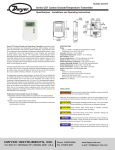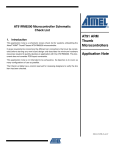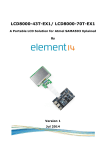Download Bulletin 825 Plus Component Configuration
Transcript
Modular Protection System Conversion Kit INSTALLATION MANUAL Bulletin 1406 to Bulletin 825 Plus Important User Information Read this document and the documents listed in the Additional Resources section about installation, configuration, and operation of this equipment before you install, configure, operate, or maintain this product. Users are required to familiarize themselves with installation and wiring instructions in addition to requirements of all applicable codes, laws, and standards. Activities including installation, adjustments, putting into service, use, assembly, disassembly, and maintenance are required to be carried out by suitably trained personnel in accordance with applicable code of practice. If this equipment is used in a manner not specified by the manufacturer, the protection provided by the equipment may be impaired. In no event will Rockwell Automation, Inc. be responsible or liable for indirect or consequential damages resulting from the use or application of this equipment. The examples and diagrams in this manual are included solely for illustrative purposes. Because of the many variables and requirements associated with any particular installation, Rockwell Automation, Inc. cannot assume responsibility or liability for actual use based on the examples and diagrams. No patent liability is assumed by Rockwell Automation, Inc. with respect to use of information, circuits, equipment, or software described in this manual. Reproduction of the contents of this manual, in whole or in part, without written permission of Rockwell Automation, Inc., is prohibited. Throughout this manual, when necessary, we use notes to make you aware of safety considerations. WARNING: Identifies information about practices or circumstances that can cause an explosion in a hazardous environment, which may lead to personal injury or death, property damage, or economic loss. ATTENTION: Identifies information about practices or circumstances that can lead to personal injury or death, property damage, or economic loss. Attentions help you identify a hazard, avoid a hazard, and recognize the consequence. IMPORTANT Identifies information that is critical for successful application and understanding of the product. Labels may also be on or inside the equipment to provide specific precautions. SHOCK HAZARD: Labels may be on or inside the equipment, for example, a drive or motor, to alert people that dangerous voltage may be present. BURN HAZARD: Labels may be on or inside the equipment, for example, a drive or motor, to alert people that surfaces may reach dangerous temperatures. ARC FLASH HAZARD: Labels may be on or inside the equipment, for example, a motor control center, to alert people to potential Arc Flash. Arc Flash will cause severe injury or death. Wear proper Personal Protective Equipment (PPE). Follow ALL Regulatory requirements for safe work practices and for Personal Protective Equipment (PPE). Allen-Bradley, Rockwell Software, Rockwell Automation, and TechConnect are trademarks of Rockwell Automation, Inc. Trademarks not belonging to Rockwell Automation are property of their respective companies. Table of Contents Introduction Chapter 1 Overview .............................................................................................. 1-1 Kit Highlights and Limitations ............................................................ 1-2 Personnel Safety ................................................................................... 1-2 Equipment Description Chapter 2 Overview .............................................................................................. 2-1 Operational Requirements .................................................................... 2-1 Ordering Information ........................................................................... 2-3 Catalog Number Breakdown ................................................................ 2-4 Unpacking and Storage Chapter 3 Overview .............................................................................................. 3-1 Unpacking Your Kit ............................................................................. 3-1 Storage .................................................................................................. 3-1 Installation Chapter 4 Overview ............................................................................................. 4-1 Pre-Installation ..................................................................................... 4-1 825 Plus Interface Panel ....................................................................... 4-2 Door Cover .......................................................................................... 4-3 Removing Low Voltage Door .............................................................. 4-4 Preparing Low Voltage Door for 825 Plus .......................................... 4-5 825 Plus ................................................................................................ 4-6 Re-Installing the Low Voltage Door .................................................... 4-7 Wiring the Control Circuit ................................................................... 4-8 Post-Installation (Testing) .................................................................. 4-10 Appendix A Bulletin 1406-P16 to Bulletin 825 Plus Conversion Kit Wire Number Table ............................................................................ A-1 Appendix B Technical Data 825 Plus ................................................................................................ B-1 Conversion Kit Interface Panel ............................................................ B-1 Converter Module ................................................................................ B-2 1500-IN058D-EN-E – June 2013 ii Table of Contents – Bulletin 1406 to 825 Plus Conversion Kit Installation Manual Appendix C Bulletin 1406-R16 to Bulletin 825P Smart Motor Manager Conversion Kit Introduction.............................................................................................. C-1 Installation Instructions ........................................................................... C-2 Bulletin 825 Plus RTD Scanner Interface Conversion Kit Wire Number Table .......................................................................... C-3 Bul. 825 Plus RTD Interface Panel Conversion Kit Wire Number Table .... C-4 Bul. 825 Plus Component Configuration ................................................. C-5 Appendix D Bulletin 825 Plus Component Configuration ....................................... D-1 Appendix E Bulletin 1406 Product Overview ............................................................ E-1 1500-IN058D-EN-E – June 2013 Chapter 1 Introduction Overview This manual describes the installation of the Bulletin 825 Plus Conversion Kit within a typical medium voltage (MV) controller. Simple troubleshooting is also included. Although this manual outlines the implementation within a medium voltage controller, the basic philosophy also applies for installation within any voltage controller where a Bulletin 1406 has been used. To use this manual effectively, you must be familiar with electrical procedures and terminology. IMPORT ANT For setup, programming, and operation information on the Bulletin 825-P Modular Protection System for Motors, refer to Publication 825-UM004_-EN-P. ATTENTION Rockwell Automation reserves the right to adapt the products described in this manual, at any time, to suit the latest technical developments. Accordingly, attached information is not an object of the contract and thus may change without notification. Prerequisite for proper operation is correct transport, proper and competent storage and installation, as well as careful operation and maintenance. 1. The power supply must be switched off prior to any intervention in the electrical or mechanical part of the equipment. 2. In accordance with the applicable rules, work on electrical equipment or means of production may only be carried out by competent electricians or suitably trained persons guided and supervised by a competent electrician. 3. The electrical equipment of a machine / plant must be inspected / tested. Deficiencies such as loose connections or scorched cables must be eliminated immediately. 4. The described control and protection system, 825 Plus, provides starting and stopping functions for a motor. ATTENTION In case of electrical or mechanical faults, the machine must be switched off and protected immediately. The elimination of disturbances must be organized without delay. Failure to do so may result in personal injury and/or damage to the equipment. 1500-IN058D-EN-E – June 2013 1-2 Introduction Overview (cont.) Kit Highlights and Limitations ATTENTION The elimination of a disturbance may cause the motor to start running again by itself. This may endanger persons or damage equipment. The user must take the necessary safety measures to protect against this type of occurrence so that any danger is avoided. The Bulletin 1406 to Bulletin 825 Plus Conversion Kit provides most of the features and functionality of the Bulletin 1406. However, the Conversion Kit also provides additional features and functions not provided/supported by the Bulletin 1406. The Bulletin 825 Plus Conversion Kit provides: • easy installation • modular design • no additional wiring • uses existing low voltage door and panels (in most cases) • various communication methods: Y – DeviceNet TM X – Modbus TM X • (12) RTD inputs with remote RTD Scanner (optional) • programmable analog output X Option card required. Y Does not support interconnection method used by the Bulletin 1406-P and 1406-AA. Note: The user must validate the control and protection capabilities of the 825 Plus. Personnel Safety 1500-IN058D-EN-E – June 2013 Protection of personnel in the vicinity of control equipment is of primary importance. The corresponding requirements of regulatory agencies are therefore becoming increasingly severe. The Bulletin 825 Plus reflects this by providing the following protection: • Equipment construction: – Touch protection – Insulated housing • Motor protective functions: – Earth (ground) fault – High overload, stalling and jam – Phase reversal Chapter 2 Equipment Description Overview This chapter describes the features of the Bulletin 1406 to Bulletin 825 Plus Conversion Kit. Operational Requirements Monitoring application parameters and process data of an installation is very important. Even a slight change in the starting and operating behavior of the motor can indicate an impending fault. The Bulletin 825 Plus helps eliminate the potential trouble before major repairs are necessary and loss of production occurs. The Bulletin 825 Plus fulfills these requirements by providing the following protective functions: • High overload, stalling • Underloading • Wrong direction of rotation However, the Bulletin 825 Plus functionality does not directly correspond to the Bulletin 1406. Below is a summary of some of the features offered by the Bulletin 825 Plus. In most cases the 825 Plus provides improved and additional features/protection. Function Description Current Transformer (Primary) Full Load Current (FLC) Bul. 1406 Parameters Bul. 825 Plus Parameters 25A – 1500A (rating) 0.5 A – 5000 A 15A – 800A 0.5 A – 5000 A Thermal Overload Protection Yes Yes Overcurrent Protection No Yes 5s – 60s 1s – 240s 10 Ω Cu, 100 Ω PI, 100 Ω Ni, 120 Ω Ni 10 Ω Cu, 100 Ω PI, 100 Ω Ni, 120 Ω Ni 1–6 1 – 12 Y 1–2 1 – 12 Y 1 – 10 (specified time increments) 1 – 15 (starts per hour) Allowable Acceleration Time Allowable RTD types Number of Winding RTDs Number of Bearing RTDs Allowable Number of Starts Phase Unbalance Trip Current Phase Unbalance Alarm Current Phase Reversal Protection 5 – 30 (percent of FLC) 5 – 80 (percent of FLC) – 5 – 80 (percent of FLC) Yes X Ye s Features require additional 1406-S option card. Y Total of twelve (12) inputs for winding, bearing or other RTD. 1500-IN058D-EN-E – June 2013 2-2 Equipment Description Operational Requirements (cont.) Function Description Bul. 1406 Parameters Bul. 825 Plus Parameters Yes Yes Jam Protection Undervoltage Protection Yes n Ye Ground Fault Alarm Current 1A – 25A 0.01 – 25A Ground Fault Trip Current 1A – 25A 0.25A – 25A Ground Fault Trip Time 10 ms – 1 s 0 – 5s Short Circuit Protection No Yes 2-10 (multiple of FLC) 1-6 (multiple of FLC) 50 – 90 (percent of FLC) 10 – 100 (percent of FLC) 1s – 10s 0 – 120s 100 – 125 (percent of FLC) 4 – 12 (multiple of FLC) Jam Trip Current Underload Trip Current Underload Trip Time Delay Ultimate Trip Current Winding Alarm Temperature 20oC – Winding Trip Temperature 20oC –180oC 0 – 250°C Bearing Alarm Temperature 20oC –180oC 0 – 250°C Bearing Trip Temperature 20oC –180oC Ambient Temperature Sensor Input 180 oC 0 – 250°C 0 – 250°C No Yes Auto/Manual Auto/Manual Speed Switch Input Yes Yes o Analog Output No Yes LC only DeviceNet, Remote I/O, PROFIBUS, Modbus Trip Contacts 2 form-C contacts (fail safe) 2 form-C contacts (fail safe) Alarm Contacts 2 form-C contacts (fail safe) 2 form-C contacts (fail safe) Reset Condition Communication P 1500-IN058D-EN-E – June 2013 s Feature requires additional 1406-S option card. An additional voltage transformer is required. Refer to Technical Data in Appendix B of this manual. Equipment Description 2-3 Ordering Information Conversion Kit Numbers Electrical Drawing Numbers Catalog Number Standard Conversion Kit 80113-650-71 825PK1-BDVXXC Standard Kit with DeviceNet 80113-650-72 825PK1-BDVDXC Standard Kit with Modbus 80113-650-73 825PK1-BDVMXC Standard Kit with RTDs 80113-650-74 825PK1-BDVXPC Standard Kit with RTDs and DeviceNet 80113-650-75 825PK1-BDVDPC Standard Kit with RTDs and Modbus 80113-650-76 825PK1-BDVMPC Description NOTE: When ordering a conversion kit with the RTD option, refer to the 825 Plus RTD Scanner Interface Installation Guide (Appendix C) for additional information. 1500-IN058D-EN-E – June 2013 Equipment Description 2-4 Catalog Number Breakdown Part Standard Conversion Kit Part Description Mounting Bezel (ANSI 49) 80185-279-05 Mounting Bezel (ANSI 61) 80185-279-06 Cutout Cover (ANSI 49) 80185-316-02 Cutout Cover (ANSI 61) 80185-316-03 Base 825 Plus Relay 825-PD 825 Plus I/O Card 825-PIOD 825 Plus Voltage Card 825-PVS 1406 to 825P Interface Panel Assembly 80185-323-52 with DeviceNet 825 Plus DeviceNet Card 825-PDN with Modbus 825 Plus Modbus RTU Card 825-PMB 825 Plus RTD Scanner wi Part Number th RTDs 1500-IN058D-EN-E – June 2013 825-PR12D RTD Scanner Mounting Assembly 80185-329-52 Fiber Optic Cable 80026-385-02 Chapter 3 Unpacking and Storage Overview This chapter describes the procedures for unpacking, inspecting, and storing the Bulletin 1406 to Bulletin 825 Plus Conversion Kit. Unpacking Your Kit As you unpack the conversion kit, follow the steps listed below: 1. Handle each component carefully to avoid damage. 2. Unpack the box(es) enough to inspect the shipment for missing or damaged equipment. 3. In the event that a component is missing, damaged, or shows evidence of rough handling, THE BUYER SHALL NOTE SUCH ON THE CARRIER’S DELIVERY RECEIPT and immediately notify the carrier. IMPORT ANT Save all packaging material for the insurance company inspection. 4. If the above conditions are not complied with, any right to recovery for missing or damaged components as described above may be forfeited. 5. Make sure that the components received are correct based on what was ordered. Storage If the Conversion Kit will be stored for any length of time, the following precautions should be taken: 1. The ambient temperature must be between -40oC to +60oC (-40°F to 140°F). 2. If the storage area is damp and/or cool, it is important to dry the Conversion Kit out in a warm, dry environment before using. Also, clean all terminals to help provide integrity of the electrical connections. 3. Cover the Conversion Kit with a heavy plastic or similar material to help prevent the accumulation of dirt on the equipment. IMPORT ANT For storage in harsh or caustic environments, consult a Rockwell Automation representative. 1500-IN058D-EN-E – June 2013 3-2 Unpacking and Storage 1500-IN058D-EN-E – June 2013 Chapter 4 Installation Overview This chapter describes the procedures for the installation of the Bulletin 1406 to Bulletin 825 Plus Conversion Kit within a medium voltage controller. Installation within other controller types can also be accomplished by following the principal philosophy of the retrofit described. Pre-installation IMPORTANT This manual is intended for use by personnel trained and familiar with medium voltage, solid-state power equipment, and general industrial controls. ATTENTION To avoid shock hazards, lock out incoming power before working on the equipment. Verify with a hot stick or appropriate voltage measuring device that all circuits are voltage free. Failure to do so may result in severe burns, injury or death. ATTENTION The National Electrical Code (NEC) and/or Canadian Electrical Code (CEC) or other local codes outline provisions for safely installing electrical equipment Failure to follow locally applicable codes can result in hazards to personnel or a non-compliant installation. Tools required: • Sheet metal cutting tools capable of cutting up to 12 gauge material • Hand drill, and drill bits • Screw drivers • Allen-key wrench set • Drop sheets or tarp ATTENTION The following pictures shown are illustrating a common controller layout. These pictures may not necessarily illustrate the exact equipment on which this kit is being installed. The pictures should be used as a general basis only. 1500-IN058D-EN-E – June 2013 4-2 Installation 825 Plus Interface Panel ATTENTION Disconnect and lockout all sources of power entering the low voltage compartment where the 1406-P16 is located. This may include opening the main disconnect isolation switch. Failure to disconnect and lock out power can result in personal injury and/or damage to the equipment. 1. Disconnect the control wires connected to the 1406-P16. Using the wire number table in Appendix A, mark each wire with the corresponding 1406 terminal block number for reference later in the procedure. 2. Remove the 1406-P16 module from the low voltage panel. Save all the mounting hardware. (Figure 4.1) Figure 4.1 3. Use the saved mounting hardware from the previous step to mount the 825 Plus Interface Panel in the same location the 1406 occupied. (Figure 4.2) IMPORT ANT Figure 4.2 1500-IN058D-EN-E – June 2013 If a 1406-R16 RTD module was used with the 1406-P16, the RTD module must also be removed. The RTD wiring to the old 1406 RTD module must be rewired to the 825 Plus RTD Panel. Refer to the 825 Plus RTD Panel Installation Guide (Appendix C). Handle existing wiring with care. Replace any damaged or worn wiring. Installation 4-3 Door Cover 1. Disconnect and remove the communication cable from 1406 programming module, located on the low voltage door. (Figure 4.3) 2. Remove the 1406 programming module from the low voltage door. Save the mounting hardware for use later in the installation process. (Figure 4.4) Figure 4.3 Figure 4.4 3. Use the saved hardware to mount the 1406 door filler cover supplied with the conversion kit. Ensure that the correct colored door filler cover is used. The 825 Plus Conversion Kit contains ANSI 49 and 61 colored door filler covers. (Figures 4.5 and 4.6) Figure 4.5 Figure 4.6 1500-IN058D-EN-E – June 2013 4-4 Installation Removing Low Voltage Door IMPORT ANT Figure 4.7 It is recommended to remove the low voltage doors to facilitate cutting the mounting hole for 825 Plus. The hole can be cut without removing the door if proper tools are used and blankets, drop sheets or tarps are used to prevent drill and saw chips from entering the controller. If you chose to do so, skip to page 4-5 and ignore page 4-7. Tip: The packing box from the 825 Plus can be used to determine feasibility of a specific mounting location. Tape the box to the rear of the low voltage door to validate the door swing and component interference on the low voltage panel. ATTENTION Failure to check for clearance can result in damage to equipment and/or personal injury. 1. Remove all door-mounted devices. Note wire numbers and locations. It is recommended to create a sketch of the component layout and associated wiring locations. (Figures 4.7 and 4.8) Figure 4.8 2. Remove the low voltage door hinge pins. Caution must be taken when removing the door. It is recommended that two people remove the door – one person to hold the door and a second person to remove the hinge pins. (Figure 4.9) ATTENTION Figure 4.9 1500-IN058D-EN-E – June 2013 Ensure sufficient personnel are present to safely remove the low voltage door. Failure to do so may result in personal injury and/or damage to the equipment. Installation 4-5 Preparing Low Voltage Door for 825 Plus Hinge Side 1. Once the door has been removed, place the door on a level work surface. 2. Position an 825 Plus Mounting Collar squarely on the low voltage door to locate the required cutout. (Figure 4.10) IMPORT ANT Figure 4.10 Position the 825 Plus cutout on the door properly to ensure that the low voltage door and low voltage panel can swing open without difficulty. It is recommended that the edge of the cutout be positioned at least 5 inches (127 mm) from the unhinged side of the low voltage door, to allow for proper clearance to open the low voltage door with the 825 Plus installed. 3. Using the collar as a template, lightly trace the cutout area on the inside and outside of the collar. This outline represents the minimum and maximum size required by the 825 Plus relay. (Figure 4.11) 4. Drill a pilot hole in the center of the traced cutout area. (Figure 4.12) Figure 4.11 5. Double-check the measurements before cutting. With a cutting tool, cut on the outside edge of the inside cutout trace. (Figure 4.13) 6. To ensure the hole is of the correct size, place a mounting collar over the hole. There should be no metal showing on the inside of the collar, and the collar should not pass through the cutout. (Figure 4.14) Min. 5" IMPORT ANT Remove all metal chips before mounting the 825 Plus. ATTENTION Failure to remove all metal chips can result in equipment damage or hazardous operation. Figure 4.12 Figure 4.13 Figure 4.14 1500-IN058D-EN-E – June 2013 4- Installation Preparing Low Voltage Door for 825 Plus (cont.) 1. Mount the 825 Plus through the low voltage door cutout. Remember to place a mounting collar on both sides of the low voltage door. (Figure 4.15) 2. Fasten the 825 Plus to the low voltage door using the mounting hardware provided with the 825 Plus. Figure 4.15 3. Before completely tightening the mounting hardware ensure the 825 Plus is mounted on a level plane both horizontally and vertically. (Figures 4.16 and 4.17) Figure 4.16 1500-IN058D-EN-E – June 2013 Tighten the screws with minimal force. Do not over tighten. Figure 4.17 Installation 4-7 Re-installing the Low Voltage Door 1. Re-install the low voltage door. Caution must be taken when reinstalling the door. It is recommended that two people remount the door – one person to hold the door and a second person to replace the hinge pins. (Figure 4.18) ATTENTION Ensure sufficient personnel are present to safely replace the low voltage door. Failure to do so may result in personal injury and/or damage to the equipment. 2. Remount all door-mounted devices that were removed. (Figure 4.19) Figure 4.18 Figure 4.19 1500-IN058D-EN-E – June 2013 4-8 Installation Wiring the Control Circuit 1. Reconnect the control wires to the corresponding 825 Plus Interface Panel terminal blocks. These are located and numbered the same as those on the 1406-P16. Use the wire number table (created as part of the procedures on page 4-2) in Appendix A, to verify the wire numbers and the terminal block location. (Figures 4.20 and 4.21) 2. Using the provided spiral wrap, combine the existing and new door control wire bundles. (Figure 4.22) Figure 4.20 Figure 4.21 1500-IN058D-EN-E – June 2013 Figure 4.22 Installation 4-9 3. Route the new wire harness along the low voltage door to the 825 Plus. (Figure 4.23) 4. Cut, strip, and connect each numbered wire to the corresponding numbered green 825 Plus terminal plug. 5. Route the black converter module cable along the low voltage door and plug the telephone style connector to the back of the 825 Plus. IMPORT ANT Figure 4.23 Refer to the supplied wiring diagram during installation of 825 Plus Interface Panel. Refer to the Ordering Information section for Electrical Diagram (ED) drawing number. 6. If the RTD option is used, refer to the 825 Plus RTD Scanner Installation Guide (Appendix C) for additional information. ATTENTION Failure to reconnect all wires and cables correctly may result in equipment damage, personal injury and/or death. 1500-IN058D-EN-E – June 2013 4-10 Installation Post Installation (Testing) ATTENTION Failure to follow these steps can result in damage to equipment and/or personal injury. 1. Inspect the interior of the enclosure for contamination, loose bolts, tools or metal chips, and vacuum clean if necessary. 2. Account for all the tools used. If a tool or hardware is unaccounted for, do not energize the equipment. 3. Inspect the wiring and the control scheme to ensure proper operation. Extra care should be taken when inspecting the connections for the current transformer and ground fault circuits, to ensure neither circuit is open or short-circuited during power-up. Figure 4.24 4. For medium voltage controllers, follow items 5 though 7. For other styles of controllers, the intent of this section is to apply control voltage to the controller circuit, including the 825 Plus. 5. The isolation switch must be in the fully opened position (the isolation switch handle moved to the OFF/down position). 6. Connect a remote 120VAC external power source to the ‘NORMAL-OFF-TEST’ (N-O-T) switch assembly test receptacle located in the low voltage compartment. (Figure 4.24 ) 7. Turn the N-O-T selector switch to the TEST position. (Figure 4.25) IMPORT ANT Figure 4.25 1500-IN058D-EN-E – June 2013 With the selector switch in the test position, power will be applied to the control circuit. Additional caution must be taken to prevent accidental contact with the 120VAC. Installation 4-11 8. Test the control circuit functionality by electrically operating the contactor (air or vacuum) in test mode (Figure 4.26). This may require the use of test jumpers depending on the control circuit. Refer to original drawings supplied with the equipment. 9. Program the 825 Plus with the correct motor and protection parameters (Figure 4.27). Refer to the User Manual publication 825-UM004_-EN-P included with the 825 Plus for programming instructions. 10. Turn test switch to OFF. Return the controller to service by removing any test voltage supply and turning the selector switch back to the "NORMAL" position. 11. Close the low voltage door and tighten down the door screws. Figure 4.26 Figure 4.27 1500-IN058D-EN-E – June 2013 4-12 Installation 1500-IN058D-EN-E – June 2013 Appendix A Bul. 1406-P16 to Bulletin 825 Plus Conversion Kit Wire Number Table TB1 TB # TB2 Wire # TB # 1 8 2 7 3 6 4 5 5 4 6 3 7 2 8 1 Wire # 9 10 11 12 13 14 15 TB3 16 17 TB # 18 6 19 5 20 4 21 3 22 2 23 1 Wire # (Copy As Required.) 1500-IN058D-EN-E – June 2013 A-2 1500-IN058D-EN-E – June 2013 Appendix B Technical Data 825 Plus Refer to Publication 825-UM004_-EN-P. Conversion Kit Interface Panel Description Specification Ground Fault Interposing Current Transformer Primary 1A Secondary 5A Operating Frequency Class 600 Accuracy Primary Impedance Approvals Important: 50/60 Hz V Less than 2% ratio error at 5 VA burden 2.5 ohms CSA certified and UL listed This current transformer is used to step down an existing 50:5 ground fault current transformer. The secondary of this current transformer is connected to the secondary of the existing ground fault current transformer. This results in an equivalent 50:1 ground fault current transformer. This is done to prevent possible damaging current levels for the 825 Plus. Voltage Transformer (not provided with the standard kits) (Optional for speed switch appliclations) Primary Secondary Current Rating Class Insulation Di-electric Withstand Approvals Design Type Recommended Transformer 115 V AC 24 V AC @ 60 Hz 85 mA 105°C Hi-Pot test of 2000 V RMS CSA certified and UL listed Dual bobbin design – no electrostatic shield required M anufacturer: Hammond Manufacturing P art Number: 166C24 Auxiliary Relays (Bulletin 700-HK32A1) Temperature Enclosure Coil Voltage Permissible Coil Voltage Variation Power Consumption Rated Insulation Voltage Operating: Storage: 120 V AC @ 60 Hz 102 V AC to 132 V AC ± 10% AC – 1.1 VA 250 V IEC; 300 V UL/CSA Pole to Pole (VRMS): 1500 V AC Contact to Coil (VRMS): 1500 V AC Dielectric Withstand Voltage Contacts Type Material S Mechanical Operations Switching Frequency Operations Rated Thermal Current Break Current at 120 V AC Make Current at 120 V AC Operating Time Maximum Operating Rate -30°C to +55°C (-22°F to +131°F) -55°C to +85°C (-67°F to +185°F) Transparent Dust Cover P Dropout DPDT, 2 Pole, 2 Form C ilver Cadmium Oxide (AgCdO) 5 x 106 11,800/hr 5A 3A 30 A ickup: 15 ms : 15 ms 3 Ops/s 1500-IN058D-EN-E – June 2013 B-2 Technical Data Conversion Kit Interface Panel (cont.) Description Specification Terminals (TB1 and TB3) Type Approvals Voltage Rating Maximum Current Wire Range Wire Strip Length Recommended Tightening Torque Insulation Temperature Range Screw terminal with wire clamp CSA certified and UL listed 300 V AC/DC 25 A 0.5 to 1.5 mm2 (#22 - #14 AWG) 6.4 mm (0.25 inch) 6-14 lb.-in. (0.7 – 1.6 Nm) -40°C to +105°C (-40°F to +221°F) Terminals (TB2) Type Screw terminal with #6 screw Approvals CSA certified and UL listed Voltage Rating 600 V AC/DC Maximum Current 20 A Wire Range 0.5 to 1.5 mm2 (#22 - #14 AWG) Wire Strip Length Prepared Conductors Only n Recommended Tightening Torque 12 lb.-in. (1.4 Nm) Insulation Temperature Range -40°C to +105°C (-40°F to +221°F) n Prepared conductors utilize ring, spade or hook connectors. Converter Module Description Specification Terminals 1500-IN058D-EN-E – June 2013 Bulletin 825 plug-in terminals (Range of cross-section) • 0.5 to 1.5 mm2 (20 AWG to 14 AWG), single wire • 0.5 to 1.5 mm2 (20 AWG to 14 AWG), double wire • 0.5 to 1.5 mm2 (20 AWG to 14 AWG) • Nominal 1.5 mm2 (.0023 in.2) Cat. No. 825-MCM5 • 2 x 2.5 mm2/1 x 4 mm 2 (2 x .0039 in2/1 x .006 in2) • 2 x 0.5 to 1.5 mm2 (20 AWG to 14 AWG) / 1 x 0.5 to 2.5 mm2 (20 AWG to 12 AWG) Appendix C Bulletin 1406-R16 to Bulletin 825P Smart Motor Manager Conversion Kit 825 Plus RTD Scanner • Installation Guide Introduction The 825 Plus RTD panel provides: • • • • easy installation modular design (12) configurable RTD inputs Fiber-optic communication port to 825 Plus (max. length 500 m) IMPORTANT The 1406 RTD module provided for eight (8) RTD input, six (6) stator winding RTD inputs, and two (2) bearing RTD inputs. The 825P RTD Panel provides up to 12 RTD inputs for either winding, bearing RTD inputs, and/or other applications. 1500-IN058D-EN-E – June 2013 C-2 RTD Interface Panel • Installation Guide Installation Instructions ATTENTION Failure to follow these steps can result in damage to the equipment and/or personal injury. 1. Ensure the RTD wires are disconnected from the 1406 RTD module. Using the wire number table in Appendix C, mark each wire with the corresponding 1406 RTD module terminal block number. 2. Remove the 1406 RTD module from the low voltage panel. Save all the mounting hardware. 3. Using the mounting hardware saved in the previous step, mount the 825 Plus RTD Panel in the location vacated by the 1406 RTD module. 4. Reconnect the RTD wires to the corresponding 825P RTD Panel terminal blocks. 5. Using the spiral wrap provided, combine the existing and RTD Scanner fiber-optic communication link to the back of the 825 Plus. 1500-IN058D-EN-E – June 2013 RTD Interface Panel • Installation Guide C-3 Bulletin 825 Plus RTD Scanner Interface Conversion Kit Wire Number Table TB3 TB1 825 Plus RTD Scanner TB # 1406 TB # 1 23 5 — 2 24 4 — 3 26 3 — 1406 TB # Wire # Wire # 825 Plus RTD Scanner TB # 2 — 1 — TB4 TB2 825 Plus RTD Scanner TB # 1406 TB # 1 02 16 32 2 02 15 31 3 03 14 30 4 03 13 32 5 04 12 29 6 05 11 28 7 06 10 27 8 06 9 29 9 07 8 18 10 08 7 18 11 09 6 17 12 09 5 16 13 10 4 15 14 11 3 15 15 12 2 14 16 12 1 13 1406 TB # Wire # Wire # 825 Plus RTD Scanner TB # (Copy as required.) 1500-IN058D-EN-E – June 2013 C-4 RTD Interface Panel • Installation Guide 1500-IN058D-EN-E – June 2013 Appendix D Bulletin 825 Plus Component Configuration Communication Card - DeviceNet - Modbus 825 Plus 825 Plus Interface Panel with 825-MCM 825 Plus RTD Scanner Interface Panel 1500-IN058D-EN-E – June 2013 D-2 Bulletin 825 Plus Component Configuration 1500-IN058D-EN-E – June 2013 Appendix E Bulletin 1406 Product Overview 1500-IN058D-EN-E – June 2013 E-2 Bulletin 1406 Product Overview 1500-IN058D-EN-E – June 2013 Medium Voltage Products, 135 Dundas Street, Cambridge, ON, N1R 5X1 Canada, Tel: (1) 519.740.4100, Fax: (1) 519.623.8930, www.ab.com/mvb Publication 1500-IN058D-EN-E – June 2013 Supersedes Publication 1500-IN058C-EN-E – February 2007 Copyright © 2013 Rockwell Automation, Inc. All rights reserved. Printed in Canada.
















































